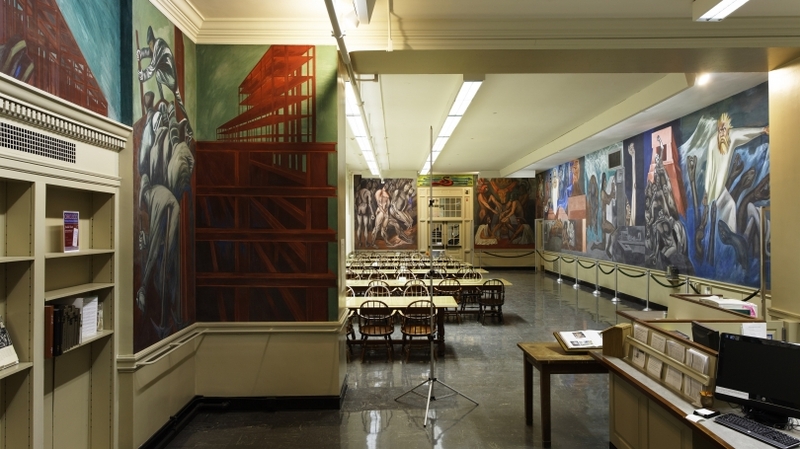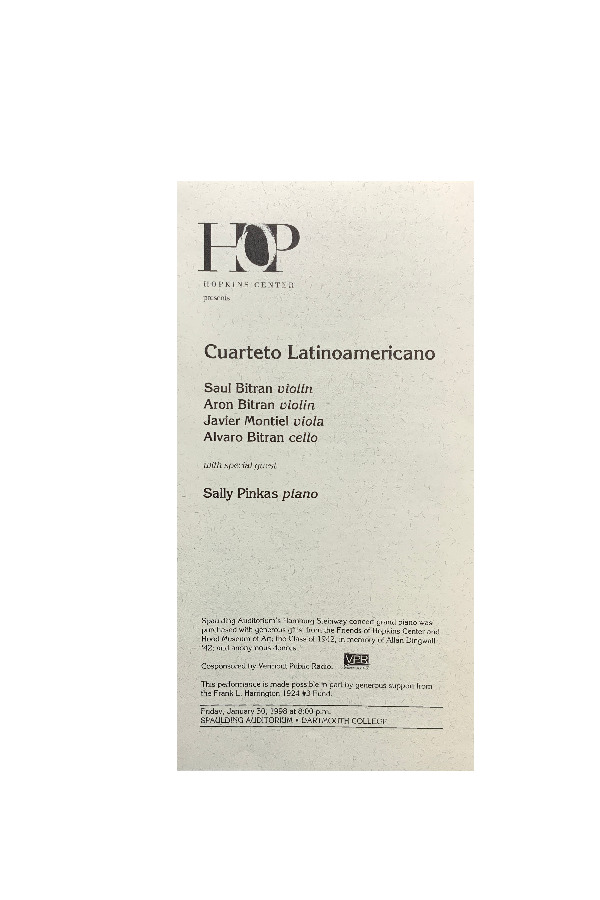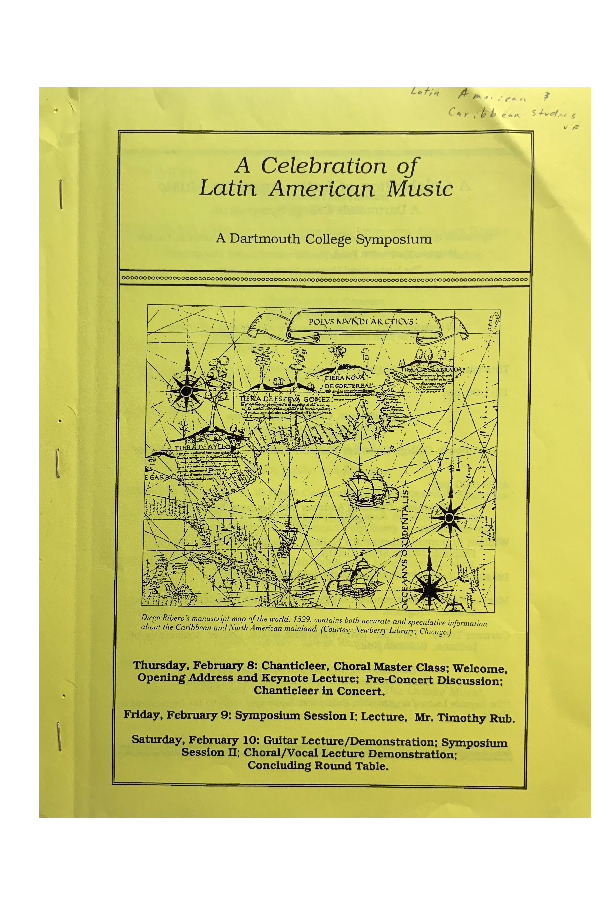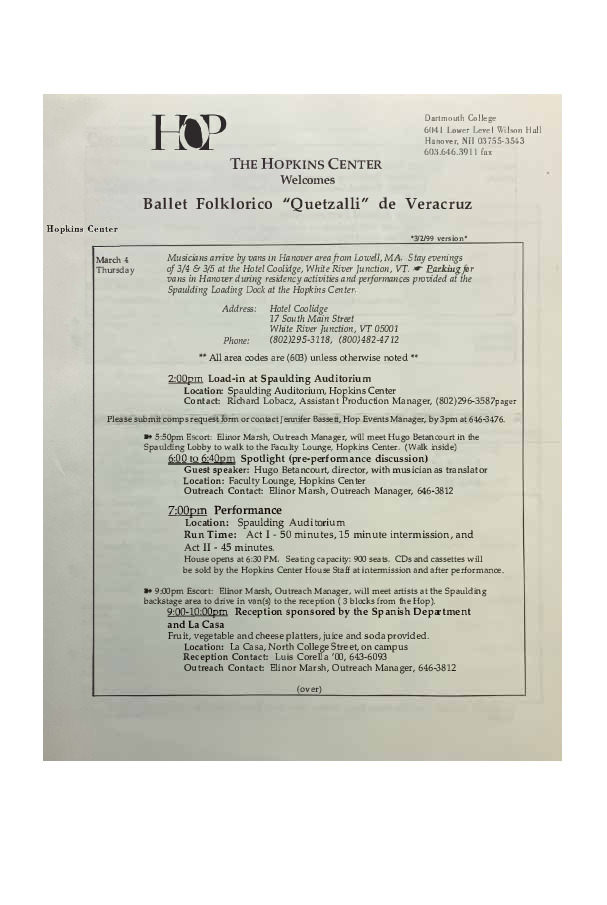The Evolution of Latino Art at Dartmouth College
This exhibit explores the history of Latino art at Dartmouth College as it relates to student life and the creation of the creation of the modern day Latino, Latin American, and Caribbean Studies Department. In its early development, the Latin American and Caribbean Studies (LACS) program had very limited resources and operated the margins of academic life at Dartmouth--a setting which Pedro Cabán describes as an "enclave." While art has always been central to Dartmouth's program in Latino Studies, the role art played in the department changed as the program developed beyond the enclave setting. This seems to match a national trend; in 2005, Taína Caragol described a recent (beginning in the 1990s) nationwide effort to create better documentation of Latino art–defined as art produced by Latinos. Although Latinos are quickly becoming more prominent in terms of population and cultural influence in the United States, their art has largely been overlooked, Caragol argues. A series of programs in large cities have collaborated with existing museums and archives to conserve Latino art and make it more accessible. This project serves to fulfill a similar goal for Latino art at Dartmouth College. An analysis of visual and performing arts is integral to an investigation of the history of the interdisciplinary Latin American, Latino, and Caribbean Studies (LALACS) program and the history of the Latino experience at Dartmouth College. Through a synthesis of materials from Rauner Library Special Collections and early digital resources, I found an historical progression regarding how Latino art was viewed and produced at Dartmouth in the 1990s and early 2000s. During the late 1980s and early 1990s, Latino art was viewed as an asset to the college. As the Latin American and Caribbean Studies program grew, there was a notable increase in Latino art performances in the late 1990s. Finally, the early 2000s saw an increase in the amount of published Latino student art.
Art as an asset
During the initial creation of the LACS program, pre-existent Latino art was primarily seen as an asset to Dartmouth College. In 1988, the Council for Special Programs at Dartmouth voted unanimously to support the proposal of a formal LACS program. A valid concern for any new department is simply whether the College and Library have adequate materials to support the program. In the aforementioned proposal, the very first existent asset listed was the José Clemente Orozco mural cycle. Found in the Dartmouth’s Baker Library, Orozco’s The Epic of American Civilization (1932-34) retells the standard eurocentric history of America from a story centered around Mesoamerica. The 1988 LACS Proposal argued that class visits, formal academic analyses, and academic conferences focused on Orozco’s murals helped justify the existence of a longstanding academic tradition in Latin American studies at Dartmouth College. It should be noted that the very first artist in residence at the Hood Museum of Art at Dartmouth College was Venezuelan-born Dartmouth graduate (class of 1923) Carlos Sanchez. Sanchez was deeply involved in assisting Orozco during his creation of the mural cycle. Furthermore, right after the Orozco murals, the proposal lists “plays by leading Latin American playwrights” as an asset to the College. The fact that the murals and plays were so prominently featured in the justification for the creation of the program makes it clear that Latino art was viewed as a valuable resource during this time period.
Increasing College investment in Latino art
As the LACS program got up and running in the 1990s, a new trend began to emerge in the types of Latino art present at Dartmouth College. Namely, the late 90s saw an increase in college-sponsored Latino performing art events. In 1996, the Latin American and Caribbean Studies program, Dartmouth Music Department, Hewlett Fund, John Sloan Dickey Center, and International Hispanic Music Study Group co-sponsored “A Celebration of Latin American Music.” This symposium featured lectures, concerts, guitar demonstrations, and vocal demonstrations. 1998 saw the brief visit of Grammy Award winning string quartet Cuarteto Latino Americano for a short residency and performance in the Spaulding Auditorium at the Hop. The quartet’s mission is to showcase contributions of Latino musicians and composers, who are often overlooked in the Eurocentric world of classical music. In 1999 Ballet Folklorico Quezalli de Veracruz, a touring dance group from Veracruz, Mexico, came to Dartmouth and put on a series of shows, both on campus and in the greater community (nearby public schools) as part of the Hopkins Center, Outreach and Arts Education initiative. The ballet featured cultural dances from numerous cultures around Mexico. Dartmouth student Luis Corella ‘00 was heavily involved in coordinating the reception, which was hosted at La Casa (note that the LALACS house was not yet open in 1999). The LALACS affinity house (open for housing in 2001), which was being designed and constructed during this time, also features artwork by prominent Latino and Chicano artists. Since then, the house has frequently hosted performing arts events. The art in the LALACS house, music symposium, string quartet, and ballet performances are all indicative of a greater trend in the 1990s; professional visual and performing artists were brought in at an increasing rate with the help of the relatively new LACS program, sometimes in conjunction with other Latino organizations. The newfound College infrastructure dedicated to LACS and Latino student life aided the expansion of Latino art performances.
The publication of student Latino art
Finally, beginning largely in the early 2000s, Dartmouth College experienced a notable uptick in the amount of published Latino student art, largely in the form of digital media. Some student performance groups existed before the new millennium, such as the theater group Nuestra Voces, founded in 1992. However, digital mediums allowed for easier publication and record keeping, leading to the apparent increase in material. A prime example of such digital media can be found in the New Voices section of Latino Intersections, an online journal created with the guidance of the Dartmouth Library. This segment features “text-based investigations and multimedia presentations of young Latino/a artists & performers.” The segment features Latino photography projects, dance troupes, and theater. Many of these projects were inspired by visiting artists who came to college classes and performances. Notably, Angela Vasquez ‘04, along with other undergraduate students, started a student dance group called Ballet Folklorico de Dartmouth, with the intention of exhibiting traditional Mexican dance. Vasquez, knowledgeable of her audience of Dartmouth students, hoped that this project would become a respected dance troupe that could help overcome misconceptions about the Latino community. Ballet Folklorico de Dartmouth performed at numerous events around campus and in the community, including at “the Latino Graduating Senior Honors Dinner, College classes, Orientation week… the Cinco de Mayo dinner…and at nearby New Hampshire schools.” The Dartmouth chapter of Movimiento Estudiantil Chicano de Aztlán (MEChA) also created a website that intended to feature student art, although it appears that content was never added to the section.
Conclusions
Prior to the early 2000s there was essentially no organized effort to publish student Latino art. During the 2000s, students were increasingly using college resources to form cohesive student groups like Ballet Folklorico de Dartmouth and to publish Latino art. Many of these projects were unfortunately short lived, likely because most students are only at Dartmouth for four years. But the point remains that for the first time, Dartmouth students put forth concentrated efforts to archive Latino art, like those mentioned by Caragol. Perhaps this shift is indicative of a greater change in the way that the LACS program was viewed at Dartmouth. Pedro Cabán describes Latino studies programs that operate in “enclave” settings as those that are underfunded, disregarded, and forced to operate in the margins of an institution. This seems consistent with the way Latino art was viewed in the 1980s and early 1990s; in this time period there was very little documented effort to host Latino artists or display student Latino art. Yet, the increased output of Latino art at Dartmouth in the late 1990s and early 2000s could signal a progression to what Cabán describes as a “transgressive” setting. The increase in campus-wide exposure to art produced or sponsored by the LACS program may be indicative of the “greater degree of political standing” that Cabán describes as a characteristic of programs in a transgressive setting. No longer pushed to the margins, Latino art became more prominent at Dartmouth College.
Throughout the time period from the late 1980s to the early 2000s, visual and performing arts were ingrained in both the LACS program and the Latino community at Dartmouth. The College has a longstanding academic tradition in Latino art, mostly thanks to the Orozco murals. As the LACS program grew, more resources were dedicated to Latino artists, who were commissioned to perform at sanctioned events and display their art in college-sponsored spaces. Students, often inspired by these performances, eventually formed their own groups dedicated to producing and preserving Latino art. This progression presents an interesting dichotomy; during the formulation of a Latin American Studies program, Associate Dean Marysa Navarro asserted that unlike Chicano Studies programs–in which “Hispanic students are connected with programs”–Dartmouth’s proposed Latin American Studies program would be separated from student recruitment and student life. It is clear, however, that community outreach and student involvement in extracurricular Latino art activities all benefited from the programs. At least in terms of visual and performing art, it appears that like many Chicano Studies programs described by Muñoz in Youth, Identity, Power: The Chicano Movement, the Latin American studies program at Dartmouth greatly increased student community empowerment. Even though the LACS (eventually LALACS) program was not officially connected with the Latino student community, art served as a bridge between the two.





